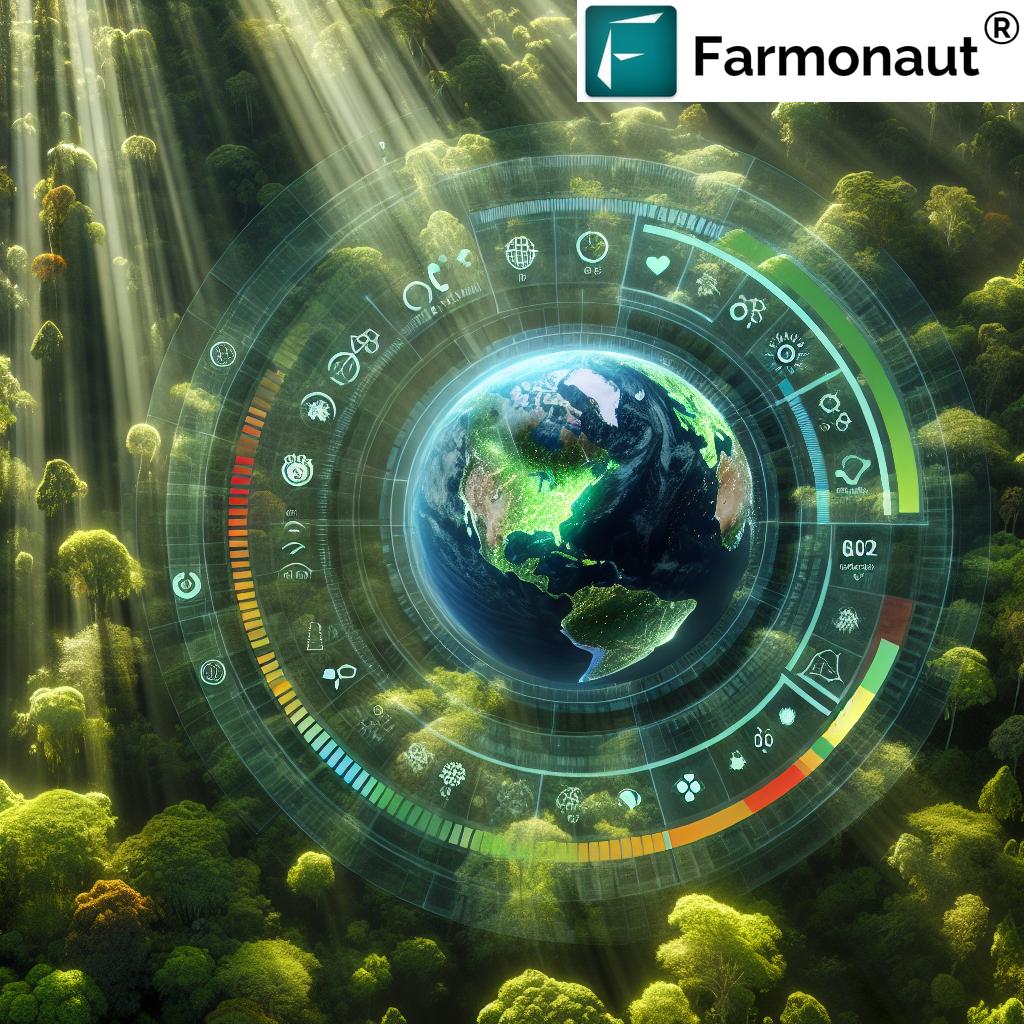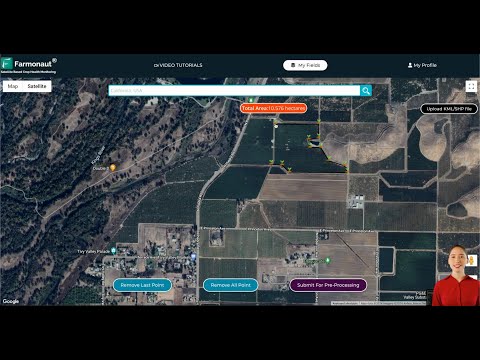Revolutionizing Sustainable Forest Management: Farmonaut’s Innovative Satellite Monitoring Solutions
“Satellite forest monitoring can detect changes in forest cover with up to 95% accuracy, revolutionizing sustainable management practices.”
In an era where environmental conservation is paramount, we find ourselves at the forefront of a revolution in sustainable forest management. As stewards of our planet’s vital green resources, we recognize the critical importance of responsible forestry practices in maintaining ecological balance and preserving biodiversity for generations to come. Today, we’re excited to explore how cutting-edge technologies, particularly Farmonaut’s innovative satellite monitoring solutions, are transforming the way we approach forest stewardship on a global scale.
The Importance of Sustainable Forest Management
Forests are the lungs of our planet, playing a crucial role in regulating climate, preserving biodiversity, and supporting countless ecosystems. Sustainable forest management is not just an environmental imperative; it’s a complex challenge that requires balancing ecological preservation with economic needs and social responsibilities. Let’s delve into why this approach is so critical:
- Biodiversity Conservation: Forests are home to over 80% of terrestrial biodiversity. Sustainable management practices help protect these habitats and the myriad species that depend on them.
- Climate Regulation: Forests act as carbon sinks, absorbing CO2 from the atmosphere. Proper management ensures this vital function continues.
- Economic Value: The forestry sector provides livelihoods for millions worldwide. Sustainable practices ensure long-term economic viability.
- Indigenous Rights: Many indigenous communities rely on forests. Responsible management respects their rights and traditional knowledge.
The Role of Technology in Forest Stewardship
As we face the challenges of climate change and increasing demand for forest resources, technology emerges as a powerful ally in our quest for sustainability. Innovative solutions are revolutionizing how we monitor, manage, and protect our forests. Among these, satellite forest monitoring stands out as a game-changer.
Farmonaut’s Satellite Monitoring: A Closer Look
Farmonaut, a pioneering agricultural technology company, has extended its expertise to forestry, offering advanced satellite-based monitoring solutions. Here’s how their technology is making a difference:
- Real-time Forest Health Assessment: Using multispectral satellite imagery, Farmonaut provides up-to-date information on forest health, including vegetation indices like NDVI (Normalized Difference Vegetation Index).
- Deforestation Detection: The platform can quickly identify areas of deforestation, allowing for rapid response and intervention.
- Ecosystem Services Valuation: By analyzing forest cover and health, Farmonaut’s tools contribute to more accurate valuation of ecosystem services.
- Integration with Blockchain: For enhanced transparency in the timber supply chain, Farmonaut’s data can be integrated with blockchain technology.
To explore these innovative solutions firsthand, visit Farmonaut’s web application:
Forest Certification Standards: Ensuring Responsible Practices
Forest certification standards play a crucial role in promoting sustainable forest management globally. These standards set the bar for responsible forestry practices, ensuring that forests are managed in a way that preserves their ecological, social, and economic values. Let’s examine some key aspects of forest certification:
- Environmental Protection: Certification requires forest managers to implement practices that protect biodiversity, water resources, and soil quality.
- Social Responsibility: Standards often include provisions for respecting indigenous rights and ensuring fair labor practices.
- Economic Viability: Certified forests must be managed to ensure long-term economic sustainability.
- Transparency and Traceability: Certification processes often involve chain-of-custody tracking, ensuring that wood products can be traced back to responsibly managed forests.
To better understand how forest certification works, let’s watch this informative video:
The EU Deforestation Regulation: A Global Impact
“The EU Deforestation Regulation affects an estimated 10-15% of global trade in forest-risk commodities, impacting businesses worldwide.”
The European Union’s Deforestation Regulation is a landmark piece of legislation aimed at curbing global deforestation driven by EU consumption. This regulation has far-reaching implications for businesses worldwide, particularly those involved in the trade of forest-risk commodities. Here’s what you need to know:
- Scope: The regulation covers commodities such as palm oil, soy, beef, wood, cocoa, and coffee.
- Due Diligence: Companies must perform due diligence to ensure their products are not linked to deforestation or forest degradation.
- Traceability: The regulation requires enhanced traceability of products throughout the supply chain.
- Global Impact: While an EU regulation, its effects ripple through global supply chains, influencing forest management practices worldwide.
Farmonaut’s satellite monitoring solutions can play a crucial role in helping businesses comply with these regulations by providing accurate, up-to-date information on forest cover and land use changes. To learn more about how Farmonaut can support your compliance efforts, check out their API documentation:
Innovative Approaches to Ecosystem Services Valuation
Understanding and quantifying the value of ecosystem services provided by forests is crucial for sustainable management. Innovative approaches are emerging to better capture these values:
- Carbon Sequestration Modeling: Advanced models using satellite data can more accurately estimate carbon storage in forests.
- Biodiversity Metrics: New methodologies are being developed to quantify biodiversity value beyond simple species counts.
- Water Regulation Services: Satellite monitoring helps assess forest contributions to water cycle regulation and quality.
- Cultural and Recreational Values: Geospatial analysis can help quantify the cultural and recreational benefits of forests.
Farmonaut’s technology contributes to these efforts by providing detailed, real-time data on forest health and coverage, enabling more accurate valuations of ecosystem services.
Deforestation Prevention Strategies: A Multi-faceted Approach
Preventing deforestation requires a comprehensive strategy that addresses the root causes while leveraging technology for monitoring and enforcement. Here are some key strategies:
- Satellite Monitoring and Early Warning Systems: Real-time detection of deforestation activities allows for rapid response.
- Community Engagement: Involving local communities in forest management enhances protection efforts.
- Sustainable Agriculture Practices: Promoting agriculture methods that reduce pressure on forests.
- Economic Incentives: Developing alternative livelihoods and payment for ecosystem services programs.
- Policy and Law Enforcement: Strengthening and enforcing laws against illegal deforestation.
Farmonaut’s satellite monitoring solutions play a crucial role in the first strategy, providing the data necessary for effective early warning systems. To see how this technology can be applied in various contexts, explore Farmonaut’s mobile applications:
Biodiversity Conservation in Forestry: A Critical Mission
Biodiversity conservation is at the heart of sustainable forest management. Forests are not just collections of trees; they are complex ecosystems teeming with life. Here’s how modern forestry practices are evolving to protect biodiversity:
- Habitat Preservation: Identifying and protecting critical habitats within managed forests.
- Connectivity Conservation: Maintaining wildlife corridors to allow species movement.
- Species-specific Management: Tailoring practices to protect endangered or keystone species.
- Invasive Species Control: Monitoring and managing non-native species that threaten biodiversity.
Satellite monitoring, like that provided by Farmonaut, helps in these efforts by offering a bird’s-eye view of forest ecosystems, allowing managers to track changes and identify areas of concern.
Indigenous Rights in Forest Management: A Crucial Perspective
Recognizing and respecting indigenous rights is fundamental to sustainable forest management. Indigenous communities often possess generations of knowledge about forest ecosystems and sustainable practices. Here’s how their rights are being integrated into modern forest management:
- Free, Prior, and Informed Consent (FPIC): Ensuring indigenous communities have a say in forest management decisions affecting their lands.
- Traditional Knowledge Integration: Incorporating indigenous wisdom into scientific forest management practices.
- Co-management Models: Developing partnerships between indigenous communities and forest managers.
- Benefit-sharing Mechanisms: Ensuring indigenous communities receive fair benefits from forest resources.
Technology can play a role in empowering indigenous communities in forest management. Farmonaut’s user-friendly interfaces make it possible for communities to access and utilize sophisticated monitoring tools, bridging traditional knowledge with modern technology.
Blockchain in Supply Chain: Enhancing Transparency and Traceability
Blockchain technology is revolutionizing supply chain management in the forestry sector, offering unprecedented levels of transparency and traceability. Here’s how it’s making a difference:
- Origin Verification: Blockchain can record and verify the origin of timber products, combating illegal logging.
- Chain of Custody: Every step of the supply chain can be recorded immutably, ensuring full traceability.
- Smart Contracts: Automated agreements can ensure compliance with sustainability standards throughout the supply chain.
- Consumer Transparency: End consumers can access detailed information about the sourcing and journey of wood products.
Farmonaut’s integration capabilities allow for seamless incorporation of satellite monitoring data into blockchain-based supply chain systems, enhancing the reliability and comprehensiveness of traceability efforts.
Comparative Analysis of Forest Monitoring Technologies
To better understand the landscape of forest monitoring technologies, let’s compare various approaches:
| Technology | Key Features | Benefits for Sustainable Forest Management | Limitations |
|---|---|---|---|
| Farmonaut’s Satellite Monitoring |
– Real-time monitoring – Wide area coverage – Integration with blockchain – AI-powered analysis |
– Rapid detection of changes – Cost-effective for large areas – Enhanced supply chain transparency – Accurate forest health assessment |
– Cloud cover can affect imaging – Limited resolution for small-scale changes |
| LiDAR |
– High-resolution 3D mapping – Penetrates forest canopy |
– Detailed forest structure analysis – Accurate biomass estimation |
– High cost for large-scale application – Requires specialized equipment |
| Drone Surveys |
– High-resolution imagery – Flexible deployment |
– Detailed local-scale monitoring – Useful for targeted inspections |
– Limited coverage area – Weather-dependent operation |
| Ground-based Sensors |
– Continuous on-site monitoring – Specific parameter measurements |
– Precise local data collection – Real-time alerts for specific events |
– Limited spatial coverage – Requires physical installation and maintenance |
This comparison highlights the unique advantages of Farmonaut’s satellite monitoring solution, particularly its ability to provide comprehensive, cost-effective coverage for large-scale forest management.
The Future of Sustainable Forest Management
As we look to the future, the integration of advanced technologies like those offered by Farmonaut will play an increasingly crucial role in sustainable forest management. Here are some trends we anticipate:
- AI-Driven Predictive Analytics: Machine learning algorithms will provide increasingly accurate predictions of forest health and potential threats.
- Internet of Things (IoT) Integration: Combining satellite data with ground-based IoT sensors for more comprehensive monitoring.
- Virtual and Augmented Reality: Enhancing visualization of forest data for better decision-making and stakeholder engagement.
- Carbon Market Integration: More sophisticated carbon accounting through advanced monitoring technologies.
To stay at the forefront of these developments, forest managers and stakeholders can leverage Farmonaut’s continuously evolving platform. Explore their API capabilities to integrate cutting-edge monitoring into your forest management practices:
Conclusion: A Collaborative Approach to Forest Stewardship
As we’ve explored throughout this blog, sustainable forest management is a complex challenge that requires innovative solutions and collaborative efforts. From advanced satellite monitoring to blockchain-enabled supply chains, from respecting indigenous rights to valuing ecosystem services, the path forward is multifaceted.
Farmonaut’s technology stands at the forefront of this revolution, offering powerful tools that enable more informed, responsive, and sustainable forest management practices. By harnessing the power of satellite imagery, AI, and data analytics, we can work together to protect our forests, preserve biodiversity, and ensure the continued provision of vital ecosystem services.
As stewards of our planet’s forests, it’s our responsibility to embrace these innovative approaches and technologies. Together, we can create a future where forests thrive, communities prosper, and the delicate balance of our global ecosystem is maintained for generations to come.
FAQs
- How does satellite monitoring contribute to sustainable forest management?
Satellite monitoring provides real-time, large-scale data on forest health, deforestation, and land use changes, enabling rapid response to threats and informed decision-making. - What are the key benefits of using Farmonaut’s technology for forest monitoring?
Farmonaut offers cost-effective, wide-area coverage with real-time updates, AI-powered analysis, and integration capabilities with blockchain for enhanced supply chain transparency. - How does the EU Deforestation Regulation affect global businesses?
The regulation requires companies to perform due diligence on forest-risk commodities, ensuring they are not linked to deforestation. This affects about 10-15% of global trade in these commodities. - What role do indigenous communities play in sustainable forest management?
Indigenous communities often possess traditional knowledge crucial for sustainable practices. Their rights and perspectives are increasingly being integrated into forest management strategies. - How does blockchain technology enhance forest product traceability?
Blockchain provides an immutable record of each step in the supply chain, from forest to consumer, enhancing transparency and verification of sustainable sourcing.





